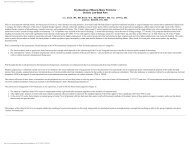Atlas of the muscle motor points for the lower limb: implications for ...
Atlas of the muscle motor points for the lower limb: implications for ...
Atlas of the muscle motor points for the lower limb: implications for ...
Create successful ePaper yourself
Turn your PDF publications into a flip-book with our unique Google optimized e-Paper software.
2464 Eur J Appl Physiol (2011) 111:2461–2471<br />
done with respect to <strong>the</strong> estimated length <strong>of</strong> <strong>the</strong> <strong>muscle</strong> (i.e.,<br />
average length <strong>of</strong> <strong>the</strong> reference line/2 <strong>for</strong> <strong>the</strong> short head <strong>of</strong><br />
<strong>the</strong> biceps femoris; average length <strong>of</strong> <strong>the</strong> reference line <strong>for</strong><br />
all <strong>the</strong> o<strong>the</strong>r <strong>muscle</strong>s). We arbitrarily defined ‘‘good’’ uni<strong>for</strong>mity<br />
<strong>for</strong> values\4%, ‘‘fair’’ uni<strong>for</strong>mity <strong>for</strong> values in <strong>the</strong><br />
range 4–6%, and ‘‘poor’’ uni<strong>for</strong>mity <strong>for</strong> values [6%. To<br />
verify <strong>the</strong> statistical significance <strong>of</strong> <strong>the</strong> differences among<br />
<strong>the</strong>se three uni<strong>for</strong>mities, we adopted <strong>the</strong> F test (MedCalc<br />
S<strong>of</strong>tware, Mariakerke, Belgium) <strong>for</strong> comparing <strong>the</strong> standard<br />
deviations (<strong>of</strong> <strong>the</strong> normalized <strong>motor</strong> point positions) <strong>of</strong><br />
different <strong>motor</strong> <strong>points</strong> identified in each <strong>muscle</strong>.<br />
Results<br />
Sixteen <strong>motor</strong> <strong>points</strong> were identified in <strong>the</strong> ten investigated<br />
<strong>muscle</strong>s <strong>of</strong> almost all subjects: <strong>the</strong> average positions <strong>of</strong><br />
<strong>the</strong>se <strong>motor</strong> <strong>points</strong> along <strong>the</strong> respective reference lines and<br />
<strong>the</strong>ir uni<strong>for</strong>mity are reported in Table 2.<br />
Three different <strong>motor</strong> <strong>points</strong> were identified <strong>for</strong> <strong>the</strong><br />
vastus lateralis <strong>muscle</strong>: a proximal <strong>motor</strong> point (blue<br />
circles in Fig. 1a) was identified in 51 out <strong>of</strong> 53 subjects, a<br />
central <strong>motor</strong> point (white circles in Fig. 1a) was identified<br />
in 42 out <strong>of</strong> 53 subjects, and a distal <strong>motor</strong> point (yellow<br />
circles in Fig. 1a) was identified in all subjects. Visual<br />
inspection and manual palpation <strong>of</strong> <strong>the</strong> <strong>muscle</strong> and its<br />
patellar tendon during stimulation allowed to distinguish<br />
among <strong>the</strong>se different <strong>motor</strong> <strong>points</strong> which activated different<br />
<strong>muscle</strong> portions (identified along <strong>the</strong> reference line<br />
from <strong>the</strong> proximal to distal aspect <strong>of</strong> <strong>the</strong> <strong>muscle</strong>): stimulation<br />
<strong>of</strong> <strong>the</strong> proximal <strong>motor</strong> point excited <strong>muscle</strong> fibers<br />
located proximally and medially, stimulation <strong>of</strong> <strong>the</strong> distal<br />
<strong>motor</strong> point excited fibers located distally and laterally, and<br />
stimulation <strong>of</strong> <strong>the</strong> central <strong>motor</strong> point excited fibers located<br />
in an intermediate position.<br />
Two different <strong>motor</strong> <strong>points</strong> were identified <strong>for</strong> <strong>the</strong> rectus<br />
femoris <strong>muscle</strong>: a proximal <strong>motor</strong> point (blue circles in<br />
Fig. 1b) was identified in all subjects and a distal <strong>motor</strong><br />
point (yellow circles in Fig. 1b) was identified in 52 out <strong>of</strong><br />
53 subjects. Proximal and distal stimulation excited fibers<br />
located laterally and medially to <strong>the</strong> reference line,<br />
respectively.<br />
Table 2 Muscles, number <strong>of</strong> cases, average positions <strong>of</strong> <strong>the</strong> <strong>motor</strong> <strong>points</strong> and <strong>the</strong>ir uni<strong>for</strong>mity are reported<br />
Muscle<br />
Number<br />
<strong>of</strong> cases<br />
Average (±SD)<br />
position <strong>of</strong> <strong>the</strong> <strong>motor</strong><br />
point along <strong>the</strong><br />
reference line (cm)<br />
Average (95% confidence<br />
limits) position <strong>of</strong> <strong>the</strong> <strong>motor</strong><br />
point along <strong>the</strong> reference line (%)<br />
Uni<strong>for</strong>mity<br />
<strong>of</strong> <strong>the</strong> <strong>motor</strong> point<br />
position (%)<br />
F statistics<br />
(significance<br />
level)<br />
Vastus lateralis: proximal<br />
<strong>motor</strong> point<br />
Vastus lateralis: central<br />
<strong>motor</strong> point<br />
Vastus lateralis: distal<br />
<strong>motor</strong> point<br />
Rectus femoris: proximal<br />
<strong>motor</strong> point<br />
Rectus femoris: distal<br />
<strong>motor</strong> point<br />
Vastus medialis: proximal<br />
<strong>motor</strong> point<br />
Vastus medialis: distal<br />
<strong>motor</strong> point<br />
51 22.5 (±4.1) a 50.3 (47.7–53.1) a 9.6 Poor F = 2.61<br />
(P = 0.002)<br />
42 15.0 (±3.2) b 34.3 (29.5–39.1) b 6.0 Fair F = 3.79<br />
53 9.5 (±1.6) b 20.6 (19.7–21.4) b 3.1 Good<br />
(P \ 0.001)<br />
53 24.8 (±2.8) b 53.2 (51.8–54.6) b 5.1 Fair F = 1.10<br />
(P = 0.73)<br />
52 16.0 (±2.4) b 35.8 (34.5–37.2) b 4.9 Fair<br />
53 10.3 (±1.6) b 22.7 (21.8–23.6) b 3.3 Good F = 1.53<br />
(P = 0.13)<br />
53 7.5 (±1.3) b 15.6 (14.9–16.4) b 2.7 Good<br />
Biceps femoris: long head 53 12.5 (±1.8) a 33.5 (32.3–34.8) a 4.5 Fair F = 10.22<br />
Biceps femoris: short head 53 13.2 (±2.6) b 39.3 (37.4–41.4) b 14.5 Poor<br />
(P \ 0.001)<br />
Semitendinosus 53 13.6 (±2.0) a 37.5 (36.1–39.0) a 5.3 Fair –<br />
Semimembranosus 53 15.5 (±2.5) b 42.6 (40.1–44.4) b 6.5 Poor –<br />
Tibialis anterior: proximal<br />
<strong>motor</strong> point<br />
52 10.5 (±1.6) a 27.5 (26.4–28.7) a 4.0 Fair F = 1.45<br />
(P = 0.18)<br />
Tibialis anterior: distal 52 16.5 (±1.9) a 43.1 (41.8–44.4) a 4.8 Fair<br />
<strong>motor</strong> point<br />
Peroneus longus 53 7.8 (±1.5) a 20.2 (19.1–21.3) a 3.9 Good –<br />
Medial gastrocnemius 53 10.1 (±2.6) a 26.0 (24.2–26.7) a 6.4 Poor –<br />
Lateral gastrocnemius 53 9.8 (±2.3) a 25.3 (23.8–26.8) a 5.5 Fair –<br />
Motor point position was measured starting from <strong>the</strong> a proximal or b distal anatomical landmark (landmarks are defined in Table 1)<br />
123






